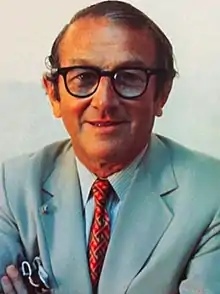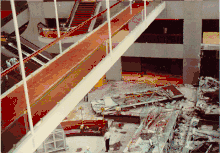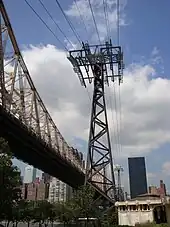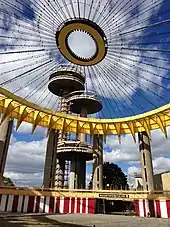Lev Zetlin | |
|---|---|
 | |
| Born | July 14, 1918 Namangan, Russia |
| Died | December 4, 1992 (aged 74) |
| Education |
|
| Occupations |
|
| Notable work | |
| British military service | |
| Allegiance | |
| Branch | British Army |
| Service years | 1941–1943 |
| Conflict | World War II |
| Israeli military service | |
| Allegiance | |
| Branch | Israeli Air Force, Haganah |
| Service years | 1948–1950 |
| Rank | Captain |
| Conflict | 1948 Arab–Israeli War |
Lev Zetlin (July 14, 1918 – December 4, 1992) was an Israeli-American civil and structural engineer. Founder of the engineering consulting firm Lev Zetlin & Associates, he developed several innovations in structural engineering including the double layer bicycle wheel roof system which he first employed at the Utica Memorial Auditorium and later patented. Zetlin was the structural engineer on 14 pavilions at the 1964–65 New York World's Fair including the New York State Pavilion which utilized his double layer cable suspended roof design.
Born in Russia, Zetlin began his career in Israel and moved in 1950 to New York to earn his master's and doctorate from Cornell University. After starting Lev Zetlin & Associates in 1956, he designed a number of structures that attracted the attention of architects such as Philip Johnson with whom he had a collaborative career. At various times during his career, Zetlin was a professor at Manhattan College, Pratt Institute, and the University of Virginia. Later in his career, he founded Zetlin-Argo Structural Investigations and consulted on several notable structural failure investigations.
Early life, education and military service
Lev Zetlin was born in Namangan, Russia, on July 14, 1918.[1] His family intended to move to Palestine in 1921 due to the Russian Civil War by way of Iran,[1][2] where Zetlin received his early education at the American College in Tehran, Iran.[1][3] He attended high school and university in Palestine. In 1939, he graduated with a diploma in civil engineering from the High Technical Institute[1][2] (now Technion) in Palestine.[3] He matriculated at the City and Guilds College in London, England, before being commissioned in the British Army from 1941 to 1943. Zetlin was later commissioned as a captain in the Israeli Air Force from 1948 to 1950[1] and fought in the 1948 Arab–Israeli War as a company commander in the Haganah,[2][4] overseeing the construction of transmission towers and other war-related structures.[5]
In 1950, Zetlin moved to the United States to attend Cornell University and graduated in 1951 with a master's in civil engineering.[1] The university invited him to remain as a research associate and work towards a doctoral thesis.[6] He earned his Ph.D. in structural engineering, applied mechanics and soil mechanics from Cornell in 1953.[1]
Career
Early career
In 1944, Zetlin started a solo engineering consulting firm in Tel Aviv. Until 1948, he worked for Israel's Department of Agricultural and Industrial Settlements as chief structural engineer while maintaining his independent consulting practice which he continued to operate until 1950.[1]
After earning his doctorate, Zetlin served as assistant professor of civil engineering at Cornell University from 1953 to 1955.[1] He also briefly worked for the Ammann & Whitney firm in New York City where his first project was designing hangar structures at John F. Kennedy International Airport.[3]
Lev Zetlin & Associates and academic career
In 1956, Zetlin founded Lev Zetlin & Associates (LZA), an engineering consulting firm in New York City,[1] and the same year began teaching advanced structures at the Engineering School of Manhattan College.[7] In 1961, he joined the Pratt Institute in Brooklyn, where he served as professor of civil engineering until 1967.[1] Zetlin served as a consultant on research for Union Carbide beginning in 1964 and was also a member of the board of consultants in civil engineering for Manhattan College in 1965.[1] Further, Zetlin was on the advisory board of the General Services Administration, an independent federal agency,[8] and served on the advisory panel of the National Academy of Sciences.[2] He was later chairman of the board of trustees at Manhattan College[2][9] and served on the New York State Council on the Arts.[2]
In 1967, he became professor of architecture and civil engineering at the University of Virginia (UVA).[8] He concurrently led the Interdisciplinary Center for Research and Innovation in Building at UVA.[10][11]
In October 1971, he sold LZA to Gable Industries, owned by J. B. Fuqua, but remained active in the firm.[12][13] By 1973, the firm was employing around 40 associates and was responsible for the structural design of airport terminals, bridges, high-rise apartments, hospitals, office buildings, offshore facilities, museums, schools and sports arenas.[13] In 1977, the firm was sold to Charles Thornton and Richard Tomasetti, both former students of Zetlin and employees of LZA, who formed the firm Thornton Tomasetti.[14]
Later consulting career
In the late 1970s, Zetlin started Zetlin-Argo Structural Investigations, a consulting firm which specialized in the forensic investigation of structural failures.[15][9] The firm, based in West Palm Beach, Florida, was involved in a number of notable investigations. In 1979–80, Zetlin served on the board investigating the cracking in the concrete of the Olympic Stadium, built for the 1976 Winter Olympics in Montreal, Canada.[9] His former firm, Lev Zetlin & Associates, and Zetlin himself were hired to look into the 1978 roof collapse at the Hartford Civic Center.[2][9]

Zetlin later investigated the collapse of a walkway at the Hyatt Regency Hotel (Kansas City, Missouri) in 1981 that killed 113 people.[9] In 1983, he investigated the Mianus River Bridge collapse on Interstate 95 in Connecticut and the roof collapse of the PATH station at Journal Square in Jersey City, New Jersey.[2]
Zetlin was hired by The Detroit News in 1986 to evaluate the Zilwaukee Bridge construction project.[9] Following his report in which he concluded that the bridge was unsafe and should not be opened, Senator Richard D. Fessler, chair of the Senate Transportation Committee of the Michigan Legislature, called for a hearing about the project.[16] Zetlin's firm also investigated the L'Ambiance Plaza collapse in Bridgeport, Connecticut, in 1987.[2]
Structural designs and innovations
On his first project after receiving his Ph.D. in 1953, Zetlin designed a building for the Hadassah Medical Center in Jerusalem while working in the U.S.[1][6] He developed a technique to allow vertical ducts to run along the columns of a flat-plate building by leaving openings in the concrete slab. While the area around columns is typically considered a weak point in the slab and would be further strained by an opening, Zetlin was able to overcome this issue by further reinforcing the area and utilizing the shear strength of concrete.[6]
In the Utica Memorial Auditorium in Utica, New York, Zetlin faced the challenge of soft soil in the area, and he needed a building that was lighter than conventional structures.[17] To accomplish this, he designed the structure with a roof suspended on two layers of cables.[6][17] Zetlin's design for the 260-feet-span roof was constructed without any cranes or scaffolding. It was able to withstand aeroelastic fluttering because one set of cables pulls against the other, damping vibrations that could lead to catastrophic failures.[13] This was the second building to employ a cable suspended roof, after the Dorton Arena, but the first to use the double layer bicycle wheel roof system.[17][18] Zetlin obtained a patent on this self-damping cable system and used it on other buildings such as the Salt Lake County Civic Auditorium.[19]
The design of the Utica Memorial Auditorium attracted the attention of architect Philip Johnson.[6] Together, they designed a nuclear reactor in Rehovot, Israel, in which Zetlin created a round building with a slightly curved roof instead of the typical "bosom" design used in nuclear reactors.[20] Zetlin and Johnson also worked on several other projects together including an art museum in Utica,[6] and the 1964–65 New York World's Fair, where Zetlin used the same double layer cable technique for the 350-foot (110 m) span of the New York State Pavilion.[13] Johnson, who was the architect of the pavilion, said that Zetlin was "the best engineer I ever had – exciting, imaginative and reliable, a combination that's hard to get."[2] Zetlin was the structural engineer for 13 other buildings at the fair.[13] Among these was the Travelers Insurance Pavillion in which he used a set of boomerang-shaped frames and a tension belt of cables to create a structure in the form of an umbrella as in the company's logo.[21] Zetlin was also the structural designer on the Kodak Pavillion for which he used a concrete shell of varying thickness to build the columns and cloud-like roof of the pavilion. On top of this roof structure was a walkway that led visitors along sculptured fountains, pools of water, and a tower featuring Kodak photographs.[22][23]

Zetlin and Johnson worked together on several other projects[24] including the Niagara Falls Convention Center which used eight steel, space frame trusses to span the 365-foot (111 m) roof.[25] Zetlin collaborated with several other architects throughout his career. With Max Abramovitz, he designed the Krannert Center for the Performing Arts at the University of Illinois at Urbana.[25] Among Zetlin's other works are the Roosevelt Island Tramway and several projects with architect I.M. Pei.[24] Zetlin was also the structural designer of the Porat Yosef Yeshiva, a religious community in Old Jerusalem, designed by architect Moshe Safdie. Zetlin used precast arch segments of wall and floor structures that can be assembled to create spaces in a variety of shapes.[26]
For the International Paper Company in 1970, he designed the Paper Bridge made out of paper and glue that allowed a 12,000 lb (5,400 kg) truck to drive over the bridge more than 40 times while spanning the 32 ft (9.8 m) over a gorge in the Valley of Fire State Park. The bridge weighing 9,000 lb (4,100 kg) is held by the Smithsonian Institution.[27] Zetlin also designed a superbay hangar for American Airlines that could fit four Boeing 747s. By 1973, two such hangars had been built in San Francisco and Los Angeles. Several of Zetlin's bold designs have yet to be tested, including several creative designs for hangars,[28] portable roof structures for aircraft,[29] structures for underwater deep-sea exploration,[30] and a reimagining of the Panama Canal with a suspension structure that would lift ships in their entirety and transport them over land.[31][32]
Awards and honors
Zetlin was elected to the Society of American Military Engineers in 1954 and became a fellow of the American Society of Civil Engineers in 1960. He was the recipient of the 1963 Progressive Architecture Award for his work on a medium security prison in Leesburg, New Jersey. He received the same award again in 1964 for his design of the Kline Science Center at Yale University.[1] In 1964, the Concrete Industry Board honored Zetlin with a special award for the Eastman Kodak Pavilion at the New York World's Fair.[1]
In 1969, Zetlin was awarded the Gold Medal from the Société Arts, Sciences, Lettres in France largely because of his work on the 1964–65 New York World's Fair.[1][25] He has twice won the Honor Award from the U.S. Department of Housing and Urban Development first for his work on the Bluebeard's Hill Apartments in Saint Thomas, U.S. Virgin Islands, in 1968, and the Charles Center in Baltimore, Maryland, in 1970.[1]
In 1972, Zetlin won the Architectural Award of Excellence from the American Institute of Steel Construction for his superbay hangar designs. He was made a Knight of Honor by the Sovereign Military Order of Malta in 1973.[1]
Personal life
Zetlin was married to Eve (née Shmueli) for 46 years. They had three children: Alexandra, Thalia, and Michael.[2] Lev Zetlin died of cardiac arrest on December 4, 1992, at the age of 74, at St. Mary's Hospital in Milwaukee, Wisconsin.[2][24] His funeral service was held in New York two days later.[24]
References
- 1 2 3 4 5 6 7 8 9 10 11 12 13 14 15 16 17 18 Wilson, Forrest (1975). Emerging Form in Architecture: Conversations with Lev Zetlin. Cahners Publishing. pp. 12–13. ISBN 0-8436-0150-7.
- 1 2 3 4 5 6 7 8 9 10 11 12 Lambert, Bruce (December 5, 1992). "Lev Zetlin, 74, an Expert on Structural Disasters". The New York Times. ISSN 0362-4331. Retrieved December 28, 2021.
- 1 2 3 Levine, Robert (June 1993). "Creativity Through Applied Science" (PDF). Modern Steel Construction. p. 14. Retrieved December 28, 2021.
- ↑ Lior, R. (June 10, 1962). "An engineer from Tel Aviv has taken the very top of American Engineering". Yedioth Ahronoth. p. 4.
- ↑ Wilson, Forrest (March 1988). "The Intuition of the Structural Engineer, Interviews with five distinguished practitioners". Architecture, the AIA Journal. 77: 76–81.
- 1 2 3 4 5 6 "Lev Zetlin Advocates a Fresh Approach to Structures". Engineering News-Record. March 4, 1965.
- ↑ Levine 1993, p. 15.
- 1 2 "Zetlin Named to Engineering Post". The Cavalier Daily. October 25, 1967.
- 1 2 3 4 5 6 Mleczko, Louis (1986). "Bridge and building expert". The Detroit News.
- ↑ Levine 1993, p. 16.
- ↑ "Engineer Claims Technology Can Cut Building Costs 90%". Philadelphia Daily News. UPI. June 25, 1969.
- ↑ McQuade, Walter (November 19, 1979). "Why All Those Buildings Are Collapsing". Fortune Magazine. p. 63.
- 1 2 3 4 5 "The innovations of Lev Zetlin". Business Week. February 10, 1973.
- ↑ Levine 1993, p. 15, 18.
- ↑ Levine 1993, p. 18–19.
- ↑ Mleczko, Louis (March 2, 1987). "Bridge safety to be probed". The Detroit News. pp. 1A, 4A.
- 1 2 3 50 Years: Utica Memorial Auditorium, Commemorative Booklet. Utica Memorial Auditorium. 2010. p. 2.
- ↑ Margolius, Ivan (2002). Architects + Engineers = Structures. Wiley. p. 64. ISBN 978-0-471-49825-4.
- ↑ Levine 1993, p. 16–17.
- ↑ Wilson 1975, p. 213–214.
- ↑ Levine 1993, p. 15–16.
- ↑ Wilson, Forrest (September 1989). "The Sydney Opera House: A Survivor" (PDF). Architecture. p. 106. Retrieved February 21, 2022.
- ↑ Kuhn, Jonathan; Lantzas, Jennifer (2014). "Tomorrow's World: The New York World's Fairs and Flushing Meadows Corona Park" (PDF). The Arsenal Gallery. p. 35. Retrieved February 21, 2022.
- 1 2 3 4 "Lev Zetlin; Probed Civic Center Collapse". Hartford Courant. December 8, 1992. Retrieved December 28, 2021.
- 1 2 3 Levine 1993, p. 17.
- ↑ Wilson 1975, p. 116–117.
- ↑ Wilson 1975, p. 112–115.
- ↑ Wilson 1975, p. 176–194.
- ↑ Wilson 1975, p. 195–198.
- ↑ Wilson 1975, p. 202–207.
- ↑ Wilson 1975, p. 209–212.
- ↑ Zetlin, Lev (1975). "What Is a Civil Engineer?". The Military Engineer. 67 (439): 264. ISSN 0026-3982. JSTOR 44603626.


